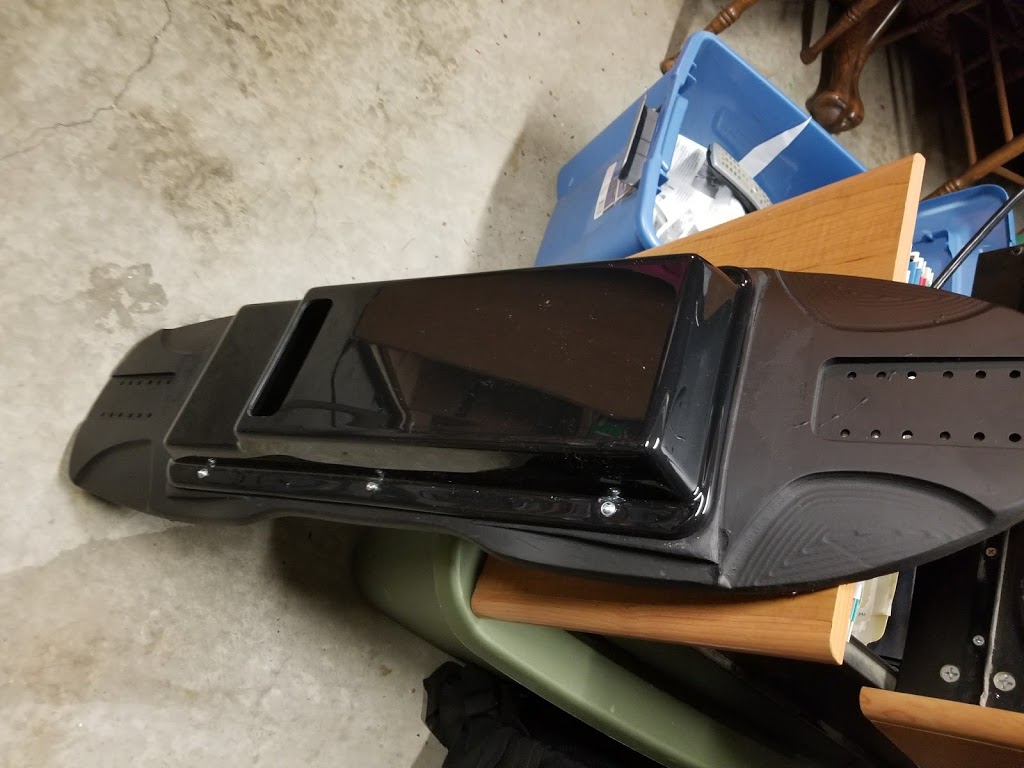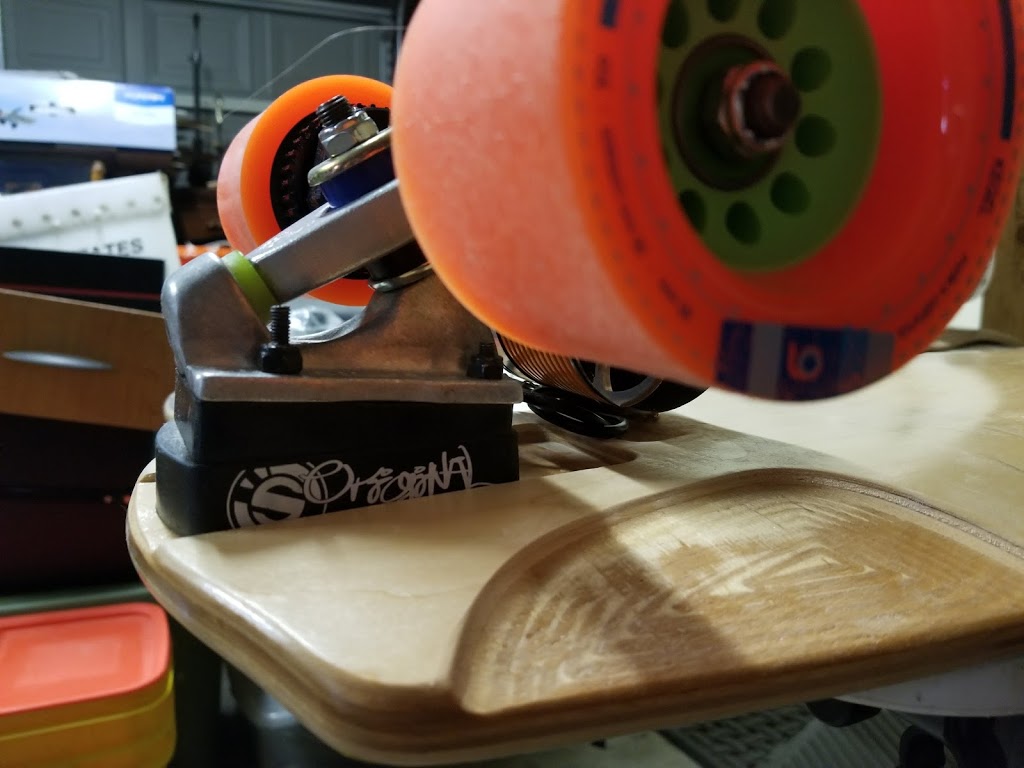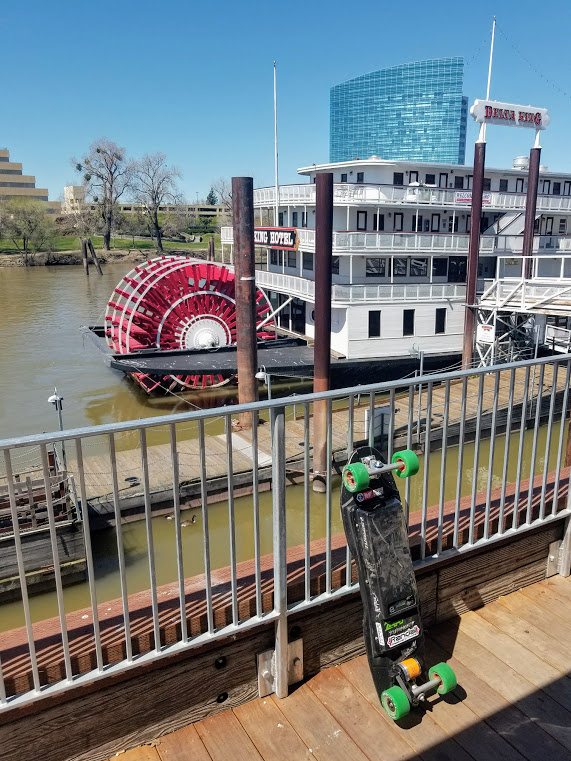I totally forgot to make a build thread for this one guys, sorry. I have been banging out projects and they sort of pop-out when they are done, not when I want them too, lol. I still want to make a video about the “skater” setup in my last build thread, so I’ll try and get that done soon. This thread is about a “commuter” setup I just finished and while it’s nothing special or new, I hope my perspective on it helps.
My previous “Skater” build: The Skaters Eskate (strength through simplicity) - #31 by Lionpuncher - ESK8 Builds - Electric Skateboard Builders Forum | Learn How to Build your own E-board
You see, I’m a skater, not a commuter, or at least I don’t want to be called a “commuter”. I picture eskate commuters as being the people who buy the electric skateboards at Frys or any big store and they look to Evolve and Boosted for measures of what a great eskate is. Many of them are 1st time buyers of any skateboard, powered or not.
I disagree, humbly, that such electric skateboards should be the measure of what is great, and believe if it’s not serviceable, then it has no place even being considered one of the top-of-the-line on the market. I cannot tell you how many threads and posts I see in social media from people waiting on their third remote from Evolve. Too bad they couldn’t just try a different remote that might work better and install it themselves and keep riding eh? Or an extended range battery, seemingly the only option to make the boosted a viable machine.
The way those larger market share holders do things is through direct support, you must get it fixed through them, buy parts from them, and you have no options really to work on the board yourself without voiding that warranty and risking making a giant paperweight. I’m a firm believer in skateboarding being a disposable art-form. They are traditionally toys, not meant to be operated like automobiles, not to be relied on as your sole means of transportation but typically thrashed in fun sessions till you hurt yourself or get tired. that;s where I come from, so the idea that a consumer would put up with that, and a company would hold it’s customers hostage like that is beyond me. It’s not setting a good precedent.
I recently discovered commuting on an electric skateboard, and it’s a thing, undeniably. I want to put-down those “commuters” who buy complete eskates and have no idea how to build or repair their boards, but they bring in a new aspect, they bring in fresh eyes, they bring in not a new way of doing things, but a new use-model from a new perspective. And I think that’s sort of cool, but they lack knowledge, skills and abilities to really take advantage of their unique and fresh perspective and hold this new genre of businesses accountable.
As a skater, I lacked the commuter perspective, when I was a kid we just went places on our skateboards because it’s all we had, we did not “commute” and never used that word, nor did we ever call our skateboards DIY because we assembled them.
When I started doing long range eskating and pushing my distances I discovered “commuting” to be a wonderful way to train. I simply needed an excuse to put on miles and feel the pain and push my ability. So, I began commuting to work, almost 10 miles one way, and when I got off work I would go run the battery down and smash another 30 miles or so, and that’s how I began pushing my ranges till I was going 50 miles on demand. I now know what it means to commute on an electric skateboard, cold foggy winter mornings and the act of “getting places safely” verses going out for the fun of it. I get it now, I understand commuting on a skateboard now and how electrics created this new form of transportation. I can no longer put down those people when I became one, and now I’m using that experience to show you what a good DIY commuter board could be, or what one may look like.
I started with a Skateshred downhill deck, it was just cheap and easy, but you can use any longboard deck you wish. I liked this deck and had been wanting to try it for a while so this gave me an excuse to test it out. I typically include a kicktail on everything but this time I left it out because the typical commuter doesn’t even know how to use one if they do have it, not trying to be negative, it’s just a fact. The parts list is basic, yet robust and this is the same power system I was able to run multiple times to 50 miles without any issues at all. I didn’t need to solder one item on this build, it was all plug-n-play, meaning any commuter without any experience, could pull this off. The hardest part would be drilling the deck and attaching the enclosure.
As you can see the deck I choose was hardly flat, it featured fenders and rocker that created a problem when I went to mate the enclosure to the deck.
I decided to have some beer and came up with a pretty interesting way to solve the problem, I will not get into the technique here because I made an entire thread about the process over here if your interested in the “epoxy pools of flatness”: Epoxy Pools of Flatness - #8 by Deckoz - ESK8 Innovations - Electric Skateboard Builders Forum | Learn How to Build your own E-board


I wanted some creative and unique grip tape art and I didn’t want to buy a print and just stick it on, so I purchased a bunch of colored grip tape and then cut it into sections that complimented the deck shape. Yellow and green have always been my livery colors, I have no idea why I like it, but it’s obnoxious and I like it that way.
I was planning to run Kegals and try them out but initial testing on the sidewalks and streets of Vegas left me wanting some Abec11 90mm right away, and that’s what I settled on. The Kegals have a sharp lip and at 80mm they do not offer enough thane to soak up the bumps and when the edges are involved in anything it gets unpredictable. The Abec11 Flywheels at least shed the rocks off the corners and are not influenced by bumps so much, whereas the Kegals need a smooth surface. They would excel at track racing or super smooth bike paths. When commuting though, you need to be ready for anything including some pebbles and rough roads. 90mm Flywheels still go over railroad track crossings and I didn’t lose any torque by using the giant 107’s which my little single motor setup would have trouble spinning efficiently.
I did do some truck upgrades and wedging to get the long wheelbase to come alive and be maneuverable. I decided on Calibers because of their zero rake stability and I’m out of precision Avenue’s right now. I installed a Randal 35-degree downhill baseplate on the rear truck, upgraded with Riptide WFB pivot cups and APS barrel bushings, and left the 50-degree baseplate up front further wedged another 15 degrees to 65. This setup allows me to keep the bushings nice and soft so I can carve at will, but the dead angle of the rear truck keeps me stable always. No wobbles at any speed, and the front turns on a dime to get me around tight corners on the sidewalk. It’s actually quite maneuverable for such a long board and wheel base and stable for how maneuverable it is.
I really like this setup, it will be my grab-and-go daytime board now. It’s not a long range super star but that’s sort of the point. This is an example of where the DIY industry is, if you want something practical, robust and simple that will last a long time and be 100% serviceable, this is a good place to start. Everything is easy to get and it was completely plug-n-play, with zero soldering. I did get creative with the epoxy and I splurged on truck upgrades because I’m normally pampered with precision trucks. I’m happy with the performance of this setup and it would serve anyone well. I plan to do some longer commutes with it and use it when I need a solid board to just get me places, like to pick up more beer!
Range is near 25 miles, top speed is 22mph and both numbers are acceptable and useful for my needs. The Torque Boards battery really made this build easy, but it’s cost was nearly half the build. This setup is over $500, but nowhere near the prices of those complete commuter boards ruling the market right now. The benefit of a DIY commuter like this is the fact you can always work on it, you know where to get parts and you can always upgrade freely.
Commuting isn’t as bad as I thought it was, but the boards still need some work to be considered reliable means of transportation. As a skater, I would choose to travel this way to get places, simply because I enjoy skateboarding so much. But if I had to rely on the device to get to work on time, pick up the kids from school or go on a date, then I think there’s room for improvement. The goal of a commuter skateboard should be to get you places, without breaking down, time and time again. We all know these things break down so the next best thing at this point is serviceability.
If you cannot service, fix, repair or maintain your own board without voiding its warranty, then I would call that an utter failure of a commuter design, and a very poor business decision for a skateboard company. We want options, we want to be able to fix it ourselves, interchange parts and keep on riding, skaters and commuters alike. How can the DIY community help make a more reliable and serviceable standard for all electric skateboard companies to learn from so we can keep skating with less problems?
and last but not least, the video:
































